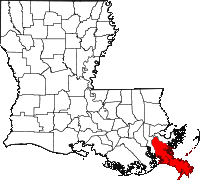|
The name
"Plaquemines" comes from a combination of
Creole and the Native American word,
piakimin, meaning persimmon. It was
first used to name an old military post on
the banks of the Mississippi which was
surrounded by a large number of persimmon
trees. Eventually the name was applied to
the entire parish.
The oldest European settlement in the parish was La Balize, where the French built and inhabited a crude fort by 1699 near the mouth of the Mississippi River. The name in French meant "seamark", a tall structure of wood built as a guide for ships. The French built one 62 feet (19 m) high by 1721. A surviving map from about 1720 shows the island and fort, and the mouth of the river. As traffic and trade on the river increased, so did the importance of river pilots who were knowledgeable about the complicated, ever-changing currents and sandbars in the river. They lived at La Balize with their families. The village was destroyed and rebuilt numerous times, but it was abandoned for good after the destruction of a September 1860 hurricane. The pilots moved upriver and built the settlement they named Pilottown, which reached its peak of population in the 19th century. The river pilots' expertise continues to be critical, but now they generally live with their families in more populated areas, and stay at Pilottown temporarily for work. One of the remaining historical treasures of Plaquemines Parish is Fort Jackson, built in 1822 under the recommendation of General Andrew Jackson, hero of the Battle of New Orleans. In 1861, Fort Jackson served as an important defense for the city of New Orleans during the Civil War because it was at the mouth of the Mississippi River. It was also used as a training base during World War I - 1917-1918. Because Plaquemines Parish encompasses the first 70 miles (110 km) of the Mississippi River, it plays host to several oil refineries which make use of the shipping lanes. The Mississippi River Delta of Plaquemines also provides assistance to offshore oil rigs. Plaquemines Parish was also the first place where a container was first used to ship cargo in foreign trade. The August 1901 Hurricane caused damage including 4 feet of water in Buras. In the early 1900s Plaquemines was an exporter of citrus, and used the train and the river to move its large annual harvest. The parish has also been a big commercial fisheries haven, especially for oysters. The Great Hurricane of 1915 devastated much of the Parish, with multiple levee breeches on both sides of the Mississippi, a 12 foot storm surge, and hundreds of deaths. Homelessness was widespread, and many were reduced to desperate starvation until charitable aid arrived. The old Parish Courthouse in Pointe à la Hache was among the many buildings destroyed in the storm, but a new one was completed within the year. From 1919 to 1969, Plaquemines Parish (together with neighboring St. Bernard Parish), was effectively the domain of political boss Leander Perez, who established a virtual dictatorship in the area. He was notorious for fixing elections and mandating strict racial segregation. Upon his death, his sons Leander Perez Jr. and Chalin Perez became the dominant political figures of the parish as district attorney and parish president, respectively, but interpersonal feuding weakened the family's hold on power and by 1980 political opponents had made serious inroads in local elections. During the Great Mississippi Flood of 1927, city and state leaders used dynamite to breach a levee at Caernarvon, thirteen miles (19 km) below Canal Street, in order to save the city of New Orleans from flooding. However, this action resulted in the flooding of much of St. Bernard and the east bank of Plaquemines parish, causing widespread destruction. In 1965 Hurricane Betsy damaged the area, flooding many areas including the Parish Courthouse, and causing 9 deaths in the Parish. Leander Perez responded by sealing the Parish off to the outside world.
Table of
Contents
Plaquemines
Parish neighbors are: Orleans Parish - North St. Bernard - N. East
Gulf of
Mexico
Get Involved!
©2010 - Present |


